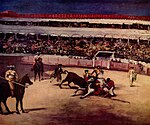
Bullfighting or tauromachy (Spanish: toreo, corrida de toros or tauromaquia; Portuguese tourada, corrida de touros or tauromaquia) is a traditional spectacle of Spain, Portugal, some cities in southern France, and several Latin American countries. Its origin is unknown, though it has been suggested that it was originally brought to Spain by the Visigoths. A link to the old culture of Crete has also been proposed.
The tradition, as it is practiced today, involves professional performers (in Spanish toreros or matadores, in Portuguese toureiros) who execute various formal moves with the goal of appearing graceful and confident, while masterful over the bull itself. Such maneuvers are performed at close range, and conclude with the death the bull by a well-placed sword thrust as the finale. In Portugal the finale consists of a tradition called the pega, where men (Forcados) are dressed in a traditional costume of damask or velvet, with long knit hats as worn by the famous Ribatejo campinos (bull headers). Bullfighting generates heated controversy in many areas of the world, including Spain, where the "classic" bullfighting was born. Supporters of bullfighting argue that it is a culturally important tradition, while animal rights groups argue that it is a blood sport because of the suffering of the bull and horses during the bullfight.